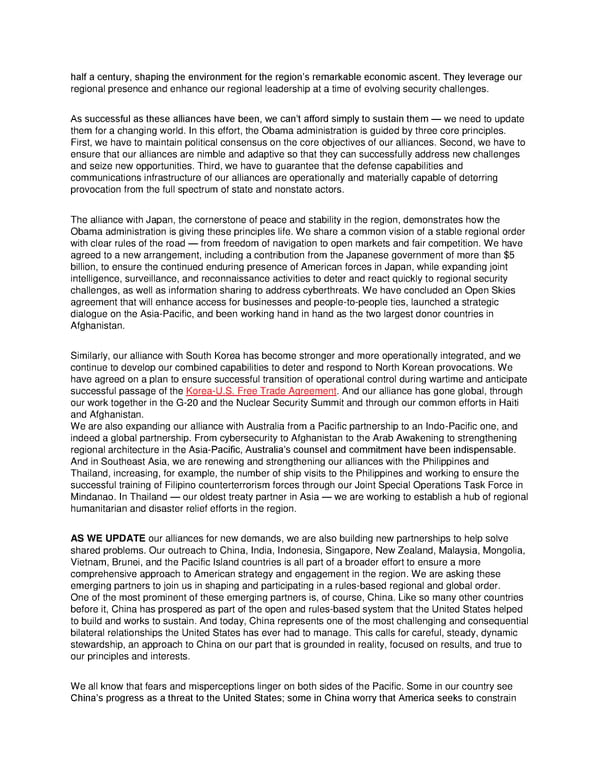half a century, shaping the environment for the region’s remarkable economic ascent. They leverage our regional presence and enhance our regional leadership at a time of evolving security challenges. As successful as these alliances have been, we can’t afford simply to sustain them — we need to update them for a changing world. In this effort, the Obama administration is guided by three core principles. First, we have to maintain political consensus on the core objectives of our alliances. Second, we have to ensure that our alliances are nimble and adaptive so that they can successfully address new challenges and seize new opportunities. Third, we have to guarantee that the defense capabilities and communications infrastructure of our alliances are operationally and materially capable of deterring provocation from the full spectrum of state and nonstate actors. The alliance with Japan, the cornerstone of peace and stability in the region, demonstrates how the Obama administration is giving these principles life. We share a common vision of a stable regional order with clear rules of the road — from freedom of navigation to open markets and fair competition. We have agreed to a new arrangement, including a contribution from the Japanese government of more than $5 billion, to ensure the continued enduring presence of American forces in Japan, while expanding joint intelligence, surveillance, and reconnaissance activities to deter and react quickly to regional security challenges, as well as information sharing to address cyberthreats. We have concluded an Open Skies agreement that will enhance access for businesses and people-to-people ties, launched a strategic dialogue on the Asia-Pacific, and been working hand in hand as the two largest donor countries in Afghanistan. Similarly, our alliance with South Korea has become stronger and more operationally integrated, and we continue to develop our combined capabilities to deter and respond to North Korean provocations. We have agreed on a plan to ensure successful transition of operational control during wartime and anticipate successful passage of the Korea-U.S. Free Trade Agreement. And our alliance has gone global, through our work together in the G-20 and the Nuclear Security Summit and through our common efforts in Haiti and Afghanistan. We are also expanding our alliance with Australia from a Pacific partnership to an Indo-Pacific one, and indeed a global partnership. From cybersecurity to Afghanistan to the Arab Awakening to strengthening regional architecture in the Asia-Pacific, Australia’s counsel and commitment have been indispensable. And in Southeast Asia, we are renewing and strengthening our alliances with the Philippines and Thailand, increasing, for example, the number of ship visits to the Philippines and working to ensure the successful training of Filipino counterterrorism forces through our Joint Special Operations Task Force in Mindanao. In Thailand — our oldest treaty partner in Asia — we are working to establish a hub of regional humanitarian and disaster relief efforts in the region. AS WE UPDATE our alliances for new demands, we are also building new partnerships to help solve shared problems. Our outreach to China, India, Indonesia, Singapore, New Zealand, Malaysia, Mongolia, Vietnam, Brunei, and the Pacific Island countries is all part of a broader effort to ensure a more comprehensive approach to American strategy and engagement in the region. We are asking these emerging partners to join us in shaping and participating in a rules-based regional and global order. One of the most prominent of these emerging partners is, of course, China. Like so many other countries before it, China has prospered as part of the open and rules-based system that the United States helped to build and works to sustain. And today, China represents one of the most challenging and consequential bilateral relationships the United States has ever had to manage. This calls for careful, steady, dynamic stewardship, an approach to China on our part that is grounded in reality, focused on results, and true to our principles and interests. We all know that fears and misperceptions linger on both sides of the Pacific. Some in our country see China’s progress as a threat to the United States; some in China worry that America seeks to constrain
 HRC America's Pacific Century Page 2 Page 4
HRC America's Pacific Century Page 2 Page 4